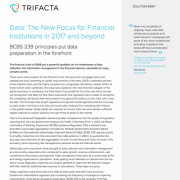Brief: How to accelerate compliance reporting with data wrangling
Join the world’s largest banks and cut compliance reporting budgets up to 60%. In this brief, Trifacta takes a closer look at how financial services companies are leveraging data wrangling to accelerate their regulatory reporting.








































